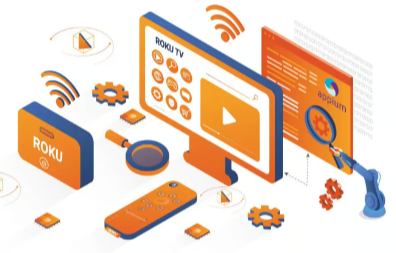A Comprehensive Guide to Roku App Development

Roku has emerged as one of the leading streaming platforms, providing users with a wide array of channels and content options. With millions of devices in use and a rapidly growing audience, the demand for Roku apps is on the rise. If you’re looking to tap into this lucrative market, understanding Roku app development is essential. This blog post will guide you through the fundamentals of developing applications for the Roku platform, covering everything from the basics to advanced features.
Understanding the Roku Platform
Before diving into app development, it’s important to grasp the fundamentals of the Roku platform. Roku devices are designed to stream content over the internet, offering users access to various streaming services and channels, including movies, TV shows, sports, and music. The user interface of Roku is straightforward, allowing users to easily navigate through channels and content.
Roku provides developers with a unique opportunity to reach a diverse audience. By creating apps for Roku, developers can offer users innovative and engaging experiences, whether it’s through video streaming, games, or interactive applications. The Roku ecosystem includes not only the devices themselves but also the Roku Channel Store, where users can discover and install new channels.
Getting Started with Roku App Development
To develop for Roku, you’ll need to become familiar with the Roku Software Development Kit (SDK). Roku apps are primarily built using a programming language called BrightScript, along with the SceneGraph framework for creating user interfaces. BrightScript is a lightweight, interpreted language designed for developing applications on the Roku platform.
The first step in your development journey is to install the Roku SDK and set up your development environment. You can download the SDK from the official Roku developer website, which includes documentation, samples, and tools to help you get started. After setting up the SDK, you will have access to various resources that will assist you in your development process.
To develop and publish your Roku app, you’ll also need to create a Roku developer account. This account will allow you to access the Roku Developer Dashboard, where you can manage your apps, track performance metrics, and access resources for app submission. Setting up your developer account is straightforward and requires only basic information about yourself and your application.
Once you’ve set up your development environment and developer account, you can start building your first Roku app. Begin by outlining the app’s functionality and features. Consider what type of content you will provide—whether it will be a video streaming app, a game, or an interactive experience—and think about your target audience and what will keep them engaged.
The basic structure of a Roku app involves creating a main scene that serves as the entry point for your application. You will define your scene using BrightScript and create components using the SceneGraph framework. As you develop, make sure to leverage the resources available on the Roku developer site, such as sample applications and documentation, to guide your progress.
Designing User Interfaces for Roku Apps
When it comes to designing user interfaces for your Roku app, simplicity and functionality are key. Roku’s user interface guidelines recommend focusing on clear navigation and an intuitive layout. Users should be able to find what they’re looking for with minimal effort. Utilize the SceneGraph framework to create visually appealing and responsive designs that enhance user experience.
Incorporating engaging visuals and animations can help make your app more attractive. However, it’s important to strike a balance between aesthetics and performance. Avoid overloading your app with heavy graphics that may slow down performance or distract users from the content. Instead, focus on a clean design that highlights the content and maintains smooth navigation.
Testing Your Roku App
Once you’ve built your app, thorough testing is essential to ensure that it functions correctly across different devices and scenarios. Roku provides a variety of tools for testing, including the Roku Device and Emulator. The emulator allows you to simulate different Roku devices on your computer, enabling you to test the functionality of your app without needing to deploy it to an actual device.
When testing, pay attention to key performance indicators such as loading times, responsiveness, and overall user experience. Gathering feedback from real users during beta testing can also provide invaluable insights that can help you refine your app before launch.
Read more: Compact Elegance: Find Your Ideal three and 2 Seater Sofas
Publishing Your Roku App
After thorough testing, the next step is to publish your Roku app. You can do this through the Roku Developer Dashboard. Submit your app along with all the necessary details, such as a description, category, and any promotional images. Roku reviews all submissions to ensure that they meet their guidelines and quality standards.
Once your app is approved, it will be available in the Roku Channel Store, making it accessible to millions of Roku users. Promoting your app through social media, email marketing, and other channels can help attract users and drive downloads.
Maintaining and Updating Your App
App development doesn’t end once your application is live. It’s important to continuously monitor its performance and gather user feedback. Regular updates not only help improve the user experience but also keep your app relevant in an ever-evolving market. Consider adding new features, fixing bugs, and ensuring compatibility with the latest Roku devices and operating systems.
Engaging with your user community through feedback and support can also lead to valuable insights that help you enhance your app. Listening to user suggestions can inspire new features or content that may improve user retention and satisfaction.
Conclusion
Roku app development offers a fantastic opportunity for developers to create engaging applications for a rapidly growing audience. By understanding the Roku platform, mastering BrightScript, and following best practices for design, testing, and maintenance, you can build successful applications that stand out in the competitive streaming market. Whether you’re creating a video streaming service, a game, or an interactive experience, the potential for success on the Roku platform is significant.




